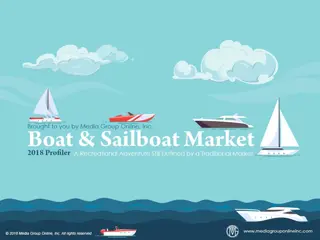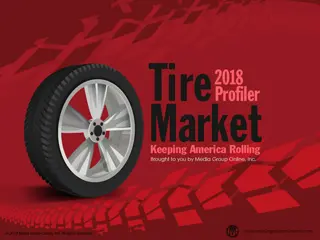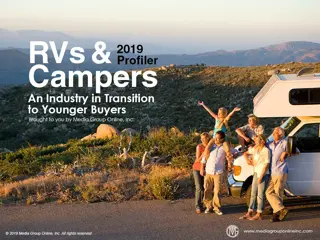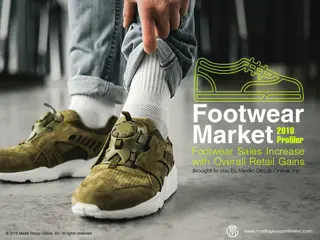Snowmobile Industry Trends and Insights 2017-2018
Snowmobile sales faced a decline in 2017 due to warm winter temperatures affecting snow levels in key regions. While US sales decreased, Canadian sales saw a smaller decline. The industry noted a shift towards dirt-to-snow kits and manufacturers adapting to market changes. Snowmobilers are typically older, family-oriented individuals who enjoy the sport as a traditional family activity. Manufacturers are innovating and dealers are adjusting to market demands.
Download Presentation

Please find below an Image/Link to download the presentation.
The content on the website is provided AS IS for your information and personal use only. It may not be sold, licensed, or shared on other websites without obtaining consent from the author. Download presentation by click this link. If you encounter any issues during the download, it is possible that the publisher has removed the file from their server.
E N D
Presentation Transcript
No Snow No Go No Sales Snowmobile sales continued to decrease during 2017. Worldwide, 118,657 snowmobiles were sold, a decrease of 6.5%, half of the previous year s decrease. US sales decreased 9.5%, to 50,659, from the previous season s 56,006. Winter 2016 2017 (January through March) was very warm, with record high temperatures, depressing snowmobile sales despite some manufacturers introducing new models for the season. The regions with the largest sales decreases were the Northeast, other than Maine, and the Upper Midwest, where there was much less snow than usual.
Flat Going North of the Border The International Snowmobile Manufacturers Association reported in its 2017 Snowmobiling Fact Book that Canadian sales during the 2016 2017 season decreased 0.6%, to 44,161 units, a much smaller decline than last year s -24.5%. Sales in Alberta were better than expected, and there were slight increases in New Brunswick and Quebec. For winter 2017 2018, most of Canada will be more mild and dry than usual with less snow, except in SE Ontario, Yukon, north Labrador and Quebec. The forecast for winter 2017 2018 in the US is colder than 2016 2017, but still warmer than usual. Precipitation will be more than normal.
Not Much Excitement in Snowville Of the snowmobile sales from August 2016 through July 2017, 46% were the current year s models, 17% were the previous year s and 37% were the future year s models. Consumers bought 7% fewer future models than they did last season. A trending phenomenon in the industry is the popularity of dirt-to-snow (DTS) kits. These kits are most popular in Idaho with 19% of the total; Montana, 16%; Utah, 16%; Colorado, 9%; Washington, 9%; and Oregon, 7%. Although more snow is expected for the 2017 2018 buying season, the majority of dealers say Q2 2017 sales were flat YOY. Only 6% of dealers are excited about snowmobile sales for the next season.
Manufacturers Pushing More Product on Dealers During March 2017, one of the 4 major snowmobile manufacturers, Arctic Cat, was purchased by Textron Inc., a company that also makes tanks, helicopters, planes, golf carts and rugged wheeled vehicles. Polaris snowmobile sales for Q2 2017 decreased 22% to $6.7 million. BRP (Ski-Doo and Lynx snowmobiles) said the segment ended the 2017 season with an increase in the low, single digits and maintained its #1 position in the industry. Dealer inventory increased 12% from the previous year s level due to weak snow.
Riding Happy The average snowmobiler is 44 years old. Three- quarters of them are married and have children living at home with them. Traditionally, people who snowmobiled as children continue in later years. Almost all (95%) consider snowmobiling to be a family activity. Snowmobile enthusiasts spend approximately $2,000 per season on the sport and ride an average of 1,175 miles per year. Their average annual household income is $68,000. A day trip will typically be 30 to 75 miles. Almost half (47%) of snowmobilers transport their snowmobiles on a trailer to riding areas, while the rest keep them at their primary or vacation home and ride them from there.
Advertising Strategies Outdoor activities are becoming more popular, and dealers can appeal to first-time snowmobilers by targeting avid hikers, jet skiers, snow skiers, motorcyclists and bicyclists. Showcase snowmobiles ease of use, light weight and maneuverability to attract more women and families. Feature snowmobiles in pre-Christmas ads and with tie-ins to the holidays, featuring a discounted bundle of accessories and other appropriate gift items.
New Media Strategies Promote a photography contest for snowmobilers with images of spectacular landscapes, close-ups of snow and ice and family fun. Invite them to post their photos on your social media pages. Ask everyone to vote for the best in various categories and reward prizes. Ask customers and enthusiasts to share their snowmobile stories and include them in a monthly email newsletter. Create and post videos with maintenance tips, snowmobile safety topics and other ideas to make the snowmobile experience more fun, especially for families.























